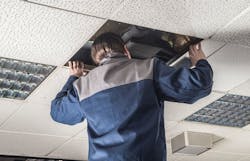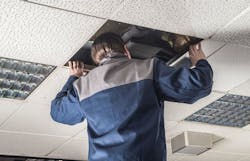Critical Code Requirements for Commercial Construction
Commercial construction includes new facilities, upgrades to existing facilities, retrofit work, and reconfiguration work. Commercial buildings include office buildings, banks, retail establishments, and other non-industrial, non-residential spaces.
Reconfiguration
Far more commercial buildings are reconfigured in some way than are built. A reconfiguration project may occur after the existing tenant moves out to customize the space for the new tenant. A grocery store and a fitness center may be able to use the same space, but they will use it in different ways. In this situation, the space is unoccupied so your crew isn’t in anyone’s way. But they may need to manage noise and construction waste because of adjacent tenants.
An existing tenant can call for reconfiguration. For example, the tenant wishes to rearrange the existing office space to convert existing cubicle space to new conference rooms. You must move receptacles, lights, cubicle power runs, and other electrical equipment — all while people are still working in the general area.
Ceiling power
Technology changes often lead to reconfiguration work (or complicate new construction). For example, think about power distribution for low-voltage devices mounted in the ceiling. Years ago, the number of such devices was usually small. Wiring in one or two wasn’t challenging. Today, however, we have dramatically more devices being specified for new and existing buildings. This can make it challenging to do a good wiring job, especially if you’re mounting individual Class 2 power supplies all over the ceiling space.
Manufacturers responded to this problem by providing “box” systems that simplify the job. The NEC responded by providing Art. 393, so installations would be safe.
Related
You can’t just set the box on top of the ceiling tiles. It must be mounted securely to the mounting surface of the building structure [393.30(A)]. Not only that, but the individual power grid rails must also be mechanically secured to the overall ceiling grid assembly [393.30(B)].
Grounding and bonding are two sources of confusion with these systems. You do connect the supply side of the Class 2 power source to an equipment grounding conductor (EGC) [393.60(A)]. You don’t connect the load side circuits to the EGC [393.60(B)].
The boxes are the core of a plug and receptacle system. You’re not running individual conductors that you must strip and terminate at each end. You’re running a cable that plugs into the box. A consortium of manufacturers makes devices that are compatible with this system. If you have a device that’s not compatible, should you make an opening in the box to accommodate it? No, because that violates the listing for the box. Replace the device with a compatible one, or install a separate power supply for it.
Transformer troubles
We all like to vent when we get “hot,” and dry-type transformers are no exception. Yet how many office buildings feature an electrical room doing quintuple duty as a janitorial supplies closet [110.11], network gear room, telephone room, paper file storage room, and storage room [110.26(3)(B)] for spare fluorescent lamps?
The room typically lacks a vented door, or the vented door is covered by duct-taped cardboard to reduce the humming noise the overheated transformers produce. Apparently, there’s a special non-flammable cardboard that is visually indistinguishable from regular cardboard... .
With no vent, how exactly are those air-cooled transformers going to cool off? In an existing installation with this problem, you can tell the transformers were not de-rated for this environment as soon as you open that door and the heat hits you in the face.
It doesn’t help that the door doesn’t have a maintenance-only lock, making the room accessible to unauthorized personnel [110.27]. Step inside this room (if you dare), and you may find two transformers only inches apart with vents facing each other or facing the wall two inches behind them [110.13(B)].
Have you noticed the preceding NEC references are all in Art. 110? The violations are many, even before looking at transformer requirements in Art. 450.
Real estate agents are adamant about the building’s location, but apathy often sets in when it comes to the location of electrical equipment within the building. There’s often one equipment closet per floor, and it contains network and phone system gear along with the transformers for powering that floor.
• New buildings get these issues when the architect tries to “save space” by clumping all “electrical” equipment together as if it’s equal, regardless of the physics involved.
• In older buildings, maybe the space was never adequate, and the network was added later. Instead of constructing a closet at the cost of leasable square footage, the owner wanted the new equipment jammed into the electrical room. “Look at all that wasted space around the transformers!”
Address equipment location issues as early as possible in the project. Don’t try to be creative to see what you can get by with; that only creates a potential liability for you. If the architect or owner won’t provide the necessary dedicated space, the job is probably not worth the risk.
Separate grounds. The crowded electrical room is perhaps the most common “really dangerous” NEC violation in commercial settings. Another common violation has to do with unbonded grounding systems.
Employees working in one large office would occasionally get a nasty shock from networked equipment (e.g., network printers). The facility manager “knew” the problem was a “bad ground” so he called an electrician to fix that. The electrician pulled out the old ground rod, drove a new one, and connected the ground wire with a brand new ground clamp. Then, in deference to the 25 ohm rule [Exception to 250.53(A)(2)], he drove a second ground rod and connected that to the first one. This didn’t solve the problem. Why?
People were getting shocked because of a difference in potential. The equipment cases were grounded to the branch circuit green wire while the network cabling shields were grounded only to a dedicated ground rod.
Grounding doesn’t eliminate differences in potential. Had the electrician bonded the network ground rod to the electrical service ground rod, the shock problem would have been solved. A different electrician solved the problem exactly this way.
Isolated ground
In an isolated ground (IG) receptacle, the grounding terminal is insulated from the metal yoke, and the grounding wire is insulated. It’s not the case that the ground is “separate” and you somehow connect the IG receptacle to a “pure” ground that doesn’t “pick up noise from the main ground.” What’s “isolated” is that yoke. The ground wire you connect to the receptacle is “isolated” from ground only to the intended point of connection (typically the branch circuit distribution panel). If installed properly, the IG receptacle is grounded (eventually) to the main supply ground. Its grounding point is bonded to other grounding points rather than being isolated from them.
If you have multiple neutral-ground current paths, the resulting ground loops play havoc with sensitive electronic equipment. Chapter 5 of IEEE Standard 142 has a good explanation of this issue. This problem is one reason IG receptacles are used.
Grounding on the load side
There’s no electrical purpose served by grounding on the load side of a service or separately derived source. A connection to earth (see Art. 100 definition of “ground”) does not do the job of bonding.
If it’s not a power source, bond it instead of ground it. Grounding instead of bonding (on the load side) sets the building up for power quality problems and lethal differences of potential. If the construction documents conflict with Art. 250 Part V, return them for revision.
That also applies to any other project documentation that calls for violating the NEC. Don’t let that monkey get put on your back. Provide the relevant references and send the documentation back for revision. If possible, review these with your counterpart — in person.
Lamendola is an electrical consultant located in Merriam, Kan. He can be reached at [email protected].
About the Author

Mark Lamendola
Mark is an expert in maintenance management, having racked up an impressive track record during his time working in the field. He also has extensive knowledge of, and practical expertise with, the National Electrical Code (NEC). Through his consulting business, he provides articles and training materials on electrical topics, specializing in making difficult subjects easy to understand and focusing on the practical aspects of electrical work.
Prior to starting his own business, Mark served as the Technical Editor on EC&M for six years, worked three years in nuclear maintenance, six years as a contract project engineer/project manager, three years as a systems engineer, and three years in plant maintenance management.
Mark earned an AAS degree from Rock Valley College, a BSEET from Columbia Pacific University, and an MBA from Lake Erie College. He’s also completed several related certifications over the years and even was formerly licensed as a Master Electrician. He is a Senior Member of the IEEE and past Chairman of the Kansas City Chapters of both the IEEE and the IEEE Computer Society. Mark also served as the program director for, a board member of, and webmaster of, the Midwest Chapter of the 7x24 Exchange. He has also held memberships with the following organizations: NETA, NFPA, International Association of Webmasters, and Institute of Certified Professional Managers.

